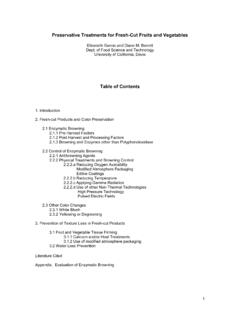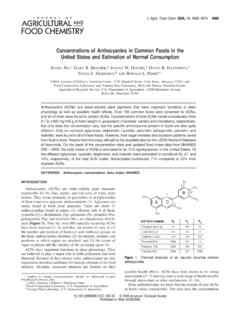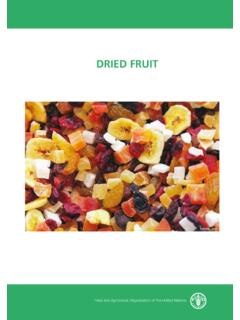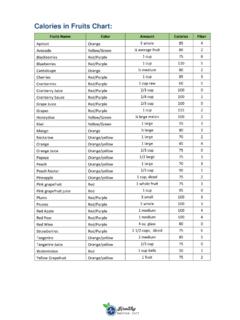Transcription of The importance of bees and other pollinators for food and ...
1 Why b e es m a tt e r The importance of bees and other pollinators for food and agriculture 20 May With the support of World Bee Day presents an opportunity to recognize the role of beekeeping, bees and other pollinators in increasing food security, improving nutrition and fighting hunger as well as in providing key ecosystem services for agriculture Jos Graziano da Silva FAO Director-General KEY FACTS AND FIGURES. Three out of four crops across the globe producing fruits or seeds for human use as food depend, at least in part, on pollinators . Improving pollinator density and diversity boosts crop yields.
2 pollinators affect 35 percent of global agricultural land, supporting the production of 87 of the leading food crops worldwide. Pollinator-dependent food products contribute to healthy diets +. 35%. and nutrition. pollinators are under threat sustainable agriculture can reduce risk to pollinators by helping to diversify the agricultural landscape and making use of ecological processes as part of food production. ! Safeguarding bees safeguards biodiversity: the vast majority of pollinators are wild, including over 20 000 species of bees. 20 000. FAO plays a leading role in facilitating and coordinating the International pollinators Initiative.
3 3.. TINY MIRACLE WORKERS. Pollination is vital to life on our the world's crops producing have become larger, agricultural planet. Bees and other pollinators fruits and seeds for human practices have also changed, have thrived for millions of consumption depend, at least in focussing on a narrower list of years, ensuring food security part, on pollinators for sustained crops and increasing the use of and nutrition, and maintaining production, yield and quality. pesticides. Mounting evidence biodiversity and vibrant The diversity of food available is points to these factors as causes ecosystems for plants, humans largely owed to animal pollinators .
4 To the potentially serious decline and the bees themselves. But alarmingly, in a number of in populations of pollinators . regions, pollination services are The decline is likely to impact pollinators are essential to the showing declining trends. the production and costs of production of many of the micro- vitamin-rich crops like fruits and nutrient rich fruits, vegetables, In the past, this service was vegetables, leading to increasingly nuts, seeds and oils we eat. provided by nature at no unbalanced diets and health In fact, close to 75 percent of apparent cost. As farm fields problems, such as malnutrition.
5 4.. BIRDS, BEES, BATS. AND MORE. So, what are they? Everyone knows about the bees, and there are some 20 000 species of wild bees that pollinate plants but it may come as a surprise to know that moths, flies, wasps, beetles and butterflies as well as some animals pollinate plants. Vertebrate pollinators include bats, non-flying mammals, including several species of monkey, rodents, lemur, tree squirrels, olingo and kinkajou, and birds such as hummingbirds, sunbirds, honeycreepers and some parrot species. The abundance and diversity of pollinators ensures the sustained provision of pollination services to multiple types of and non-communicable diseases.
6 Plants and leads to better food. Maintaining and increasing yields in horticultural crops under agricultural development is important to health, nutrition, food security and better incomes for smallholder farmers. The process of securing effective pollinators to service' agricultural fields is proving difficult to engineer, and there is a renewed interest in helping nature provide pollination services through practices that support wild pollinators .. 5.. POLLINATION: INVISIBLE TO THE EYE BUT YIELDING GREAT RETURNS. IN AGRICULTURE. Pollination is the highest agricultural contributor to yields worldwide, contributing far beyond any other agricultural management practice.
7 Thus, bees and other pollinators make important contributions to agriculture. pollinators affect 35 percent of global agricultural land, supporting the production of 87. of the leading food crops worldwide. Plus, pollination-dependent crops are five times more valuable than those that do not need pollination. The price tag of global crops directly relying on pollinators is estimated to be between US$235 and US$577 billion a year. And their quantity is on the rise. The volume of agricultural production dependent on pollinators has increased by 300 percent in the last 50 years. These figures reflect the importance that pollinators have in sustaining livelihoods across the planet.
8 Several of the crops produced with pollination, cocoa and coffee, to name two examples, provide income for farmers, in particular smallholder farmers and family farms, especially in developing countries. Bees can, in a sense, be considered as livestock. With the increasing commercial value of honey, bees are becoming a growing generator of income, livelihood strategy and means of food security for many small-scale producers and forest dwellers in many developing countries. Clearly, the benefits that bees and other small pollinators bring us go beyond human food. Thanks to these pollinators , farm animals have diverse forage sources and hence more flexibility to adapt to an increasingly changing climate.
9 And we also have certain medicines, biofuels, fibres and construction materials. Some species also provide materials such as beeswax for candles and musical instruments. So embedded in our lives, bees and other pollinators have long inspired art, music and even sacred passages.. 6.. HONEY - LIFE'S SWEETENER. In the past, honey was only considered a sweetener, whereas today we know that it contains many beneficial substances. It is an excellent nutrient and calmative. Owing to its antibacterial and antioxidant properties, it is widely used in folk medicine. Honey does not require additional processing and a beekeeper does not add anything nor take anything away from it.
10 While mature honey loses some of its nutritional value, it still remains a superior sweetener for many decades, especially compared to plain sugar. How quickly bioactive substances are lost depends on the temperature and other storage conditions. If honey is stored at room temperature, it remains unspoiled for at least two years, and even longer if stored in dry, cool and dark spaces. Honey crystallizes with time. This is a natural process that neither causes any chemical changes nor affects its quality. Crystallized honey can be liquified in a water bath; the temperature, however, must not exceed 40 C.

















